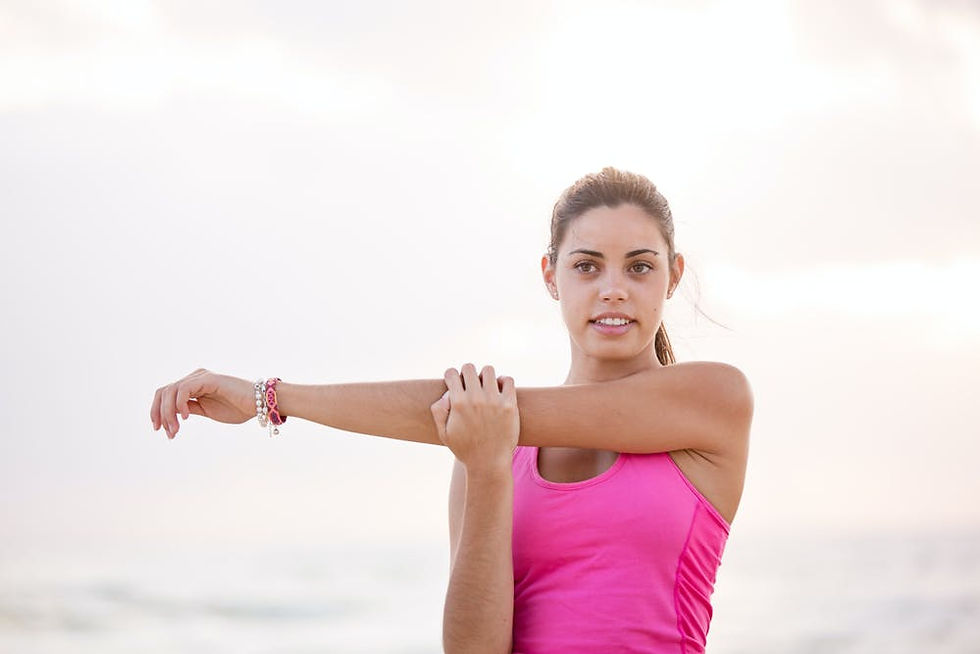Fall Walks
- BreAnne Henry
- Oct 9, 2020
- 4 min read
Fall Walks and Injury Prevention
While the weather is still nice, and the colours of Fall flourish, many of us want to get out and enjoy the captivating colours around us. Walking is an excellent form of exercise and a great way to see the season. Here are some tips to help prevent injuries, while still being able to take in the beauty that is Fall.


Make sure you stretch before hitting the trails.
Marching or jogging in placing will help get your muscles warmed up, and that is the perfect time to do dynamic stretches. Dynamic stretching that targets your range of motion is best for the sudden movements involved with walking. Start with slow, low intensity movements, and gradually progress to full-speed movements through range of motion. Complete these motions for several repetitions (10-15 times.) You may feel light resistance in your muscles while doing these movements, but you should never feel pain during a stretch!
Here are a few stretches to do before and after your walk!



It's important to warm up your muscles to avoid injuries.
Neck stretches, leg swings, ankle rotations, and spine rotations are all good methods to ensure your body is warmed up and ready for your adventure!
Shoes and Clothing!
"There's an awful lot you can tell about a person by their shoes." ~ Forest Gump. Everyone is different and so are the shoes they need! Every person has a anatomically different foot, or may be affected by a previous ankle of foot injury, so it is important to find the footwear that best serves your needs.
Running and walking are totally different when it comes to your pacing and striking. When walking you take off from, your heel, to your midfoot, and finally push off with your toes. This means that the shoe you wear walking must be flexible to being in the forefoot as your push off your midfoot and toes. You can check this by holding the shoe in your hand and simulating a step with the shoe on the ground. Watch to see that the shoe can flex and that it does so in the forefoot. Many running shoes are designed to flex further back in the midfoot area in order to accommodate the unique mechanics of running, therefore they are not as appropriate to be used as a walking shoe. A shoe that has no flexibility in it will quickly cause wear on your foot and lead to discomfort even on short walks.


Good socks are just as important as supportive shoes. The socks should be snug, but still breathable. This is best acquired through lightweight socks. Blisters happen to all of us, but you can prevent them by wearing two pairs of socks! This will help reduce friction on your skin, which creates the blister. For the best results, the first pair of socks should be made of a synthetic moisture wicking material and then the second layer can be made of either synthetic or cotton. If you do develop an area of potential blister soreness (a hotspot), it is crucial that you treat it straight away. Immediate treatment can avoid a blister developing and save walking long distances in pain. The clothing you choose for walking will depend on both your personal preference as well as the climate/environment you are walking in.
As a general rule, you should choose clothing that allows your sweat to be wicked away from your body both to keep you cool or keep you warm, which is completely weather dependent. This means choosing a synthetic layer for the clothing that is closest to your skin, rather than cotton, particularly if you are layering for warmth.
Walking/Hiking Poles
Although not essential, walking/hiking poles are highly recommended when walking, particularly if you are walking frequently, walking long distances, engaging in hill walking, or have existing knee or ankle injuries. Walking with two poles is better than just using one. Hiking poles reduce the strain on the body particularly when walking downhill. When walking uphill they also transfer some of your body weight and required effort to your upper limbs rather than loading the entire weight of your body on your lower extremities. In addition to taking some of the body load, hiking poles also increase your overall stability when walking and in this way help to decrease the incidence of falls. Choose a handgrip that is comfortable for your hand and one in which you can relax your hand and your grip while your wrist is in its natural resting position. The retention strap on the pole should be lax enough for you to slip your hand out easily if needed but short enough that your hand does not slip out upon movement. Poles used just for fitness walking do not need to be adjustable in their length as you are not enduring the extreme up and down terrain such as that of a trek. Non-adjustable poles are generally lighter and of course have no chance of collapsing if the adjuster isn’t tightened properly. If you plan on walking on several surfaces choose walking poles that have removable tips which can be replaced with baskets for walking on soft ground, or special rubber tips for walking on asphalt (paws).
Orthotics
If your feet, knees, hips or low back are hurting despite choosing appropriate equipment and having an efficient gait, it may be worthwhile trying orthotics. These inserts help to align your feet more optimally and allow you to walk with efficient biomechanics. There are a range of orthotics available on the market, from over-the-counter arch supports to custom made carbon-fibre inserts, that can fit most shoe types. Enjoy the season from your friends at Fix Physio!





Comments